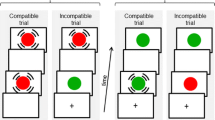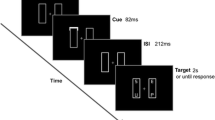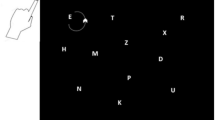Abstract
The proximity of hand position alters the processing of visual stimuli. Stimuli presented close (proximal) to hands receive an enhanced allocation of visual attention compared to stimuli presented far (distal) from hands. In the present dual-task study we studied the consequences of this preferential processing when the stimulus for Task 1 (S1) and the stimulus for Task 2 (S2) were presented together and were assigned to specific response hands (R1 and R2) located proximal (at the monitor) versus distal (in the lap) to the stimuli. In two experiments, we tested whether stimulus–hand proximity affected the extent of between-task interference (i.e., influence of additional Task 2 processing on primary Task 1 processing). In Experiment 1, results showed that stimulus–hand proximity reduced the amount of between-task interference compared to the distal stimulus–hand condition. Extending these findings, in Experiment 2 a further reduction of between-task interference was obtained when a single hand was located at the monitor instead of two hands. These results are inconsistent with the assumption of a generally increased attentional processing benefit for multiple stimuli within hand space. Instead, these findings speak for a hand-specific processing benefit that supports more separate processing of two tasks. Together these findings demonstrate that stimulus–hand proximity affects the quality of multiple task performance, which is discussed in the context of both, basic and applied cognitive research.

Similar content being viewed by others
Notes
Interference between tasks works also the other way around, i.e., S1 processing affects subsequent S2 categorization. Due to T1 prioritization, however, this forward crosstalk is of lesser theoretical importance. Yet, performance of T2 is often reported to exclude performance trade-offs between T1 and T2.
In addition to the amount of overlap within individual stimulus–response pairs, the importance of task separability on the magnitude of dual-task- and switch costs, for example, has also been highlighted in the context of input–output modality pairings in dual tasking (Halvorson, Ebner, & Hazeltine, 2013; Halvorson & Hazeltine, 2015; Maquestiaux, Ruthruff, Defer, & Ibrahime, 2018; Stelzel & Schubert, 2011) and task switching (Stephan & Koch, 2010, 2011), respectively. Here, it remains an interesting empirical question to which extent stimulus–hand proximity might also affect general task separation beyond facilitated task-specific stimulus–response binding (e.g., by discouraging feature binding across tasks).
An additional contributing factor to stronger task separation in the asynchronous PD and DP stimulus–hand conditions might be the larger spatial distance between both response hands compared to synchronous PP and DD stimulus–hand condition (Chen & Proctor, 2014; Lakens, Schneider, Jostmann, & Schubert, 2011). Spatial R1–R2 distance, however, cannot explain the entire result pattern, as in Experiment 1, R1–R2 distance was constant in both stimulus–hand conditions.
References
Abrams, R. A., Davoli, C. C., Du, F., Knapp, W. H., 3rd, & Paull, D. (2008). Altered vision near the hands. Cognition,107(3), 1035–1047.
Abrams, R. A., & Weidler, B. J. (2014). Trade-offs in visual processing for stimuli near the hands. Attention Perception & Psychophysics,76(2), 383–390. https://doi.org/10.3758/s13414-013-0583-1.
Barsalou, L. W. (2008). Grounded cognition. Annual Review of Psychology,59, 617–645. https://doi.org/10.1146/annurev.psych.59.103006.093639.
Brockmole, J. R., Davoli, C. C., Abrams, R. A., & Witt, J. K. (2013). The World within reach: Effects of hand posture and tool use on visual cognition. Current Directions in Psychological Science,22(1), 38–44. https://doi.org/10.1177/0963721412465065.
Bush, W. S., & Vecera, S. P. (2014). Differential effect of one versus two hands on visual processing. Cognition,133(1), 232–237. https://doi.org/10.1016/j.cognition.2014.06.014.
Chen, J., & Proctor, R. W. (2014). Conceptual response distance and intervening keys distinguish action goals in the Stroop color-identification task. Psychonomic Bulletin & Review,21(5), 1238–1243. https://doi.org/10.3758/s13423-014-0605-6.
Davoli, C. C., & Abrams, R. A. (2009). Reaching out with the imagination. Psychological Science,20(3), 293–295.
Davoli, C. C., & Brockmole, J. R. (2012). The hands shield attention from visual interference. Attention Perception & Psychophysics,74(7), 1386–1390. https://doi.org/10.3758/s13414-012-0351-7.
Davoli, C. C., Brockmole, J. R., Du, F., & Abrams, R. A. (2012). Switching between global and local scopes of attention is resisted near the hands. Visual Cognition,20(6), 659–668. https://doi.org/10.1080/13506285.2012.683049.
Davoli, C. C., Du, F., Montana, J., Garverick, S., & Abrams, R. A. (2010). When meaning matters, look but don’t touch: The effects of posture on reading. Memory & Cognition,38(5), 555–562. https://doi.org/10.3758/Mc.38.5.555.
Egner, T., & Hirsch, J. (2005). Cognitive control mechanisms resolve conflict through cortical amplification of task-relevant information. Nature Neuroscience,8(12), 1784–1790. https://doi.org/10.1038/nn1594.
Englert, J., & Wentura, D. (2016). Hand posture and cognitive control: The congruency sequence effect is reduced near the hands. Psychonomic Bulletin & Review. https://doi.org/10.3758/s13423-016-1000-2.
Fagioli, S., Ferlazzo, F., & Hommel, B. (2007). Controlling attention through action: observing actions primes action-related stimulus dimensions. Neuropsychologia,45(14), 3351–3355. https://doi.org/10.1016/j.neuropsychologia.2007.06.012.
Feng, S. F., Schwemmer, M., Gershman, S. J., & Cohen, J. D. (2014). Multitasking versus multiplexing: Toward a normative account of limitations in the simultaneous execution of control-demanding behaviors. Cognitive Affective & Behavioral Neuroscience,14(1), 129–146. https://doi.org/10.3758/s13415-013-0236-9.
Fischer, R., & Dreisbach, G. (2015). Predicting high levels of multitasking reduces between-tasks interactions. Journal of Experimental Psychology: Human Perception and Performance,41(6), 1482–1487. https://doi.org/10.1037/xhp0000157.
Fischer, R., Fröber, K., & Dreisbach, G. (2018). Shielding and relaxation in multitasking: Prospect of reward counteracts relaxation of task shielding in multitasking. Acta Psychologica,191, 112–123. https://doi.org/10.1016/j.actpsy.2018.09.002.
Fischer, R., Gottschalk, C., & Dreisbach, G. (2014). Context-sensitive adjustment of cognitive control in dual-task performance. Journal of Experimental Psychology. Learning, Memory, and Cognition,40(2), 399–416. https://doi.org/10.1037/a0034310.
Fischer, R., & Hommel, B. (2012). Deep thinking increases task-set shielding and reduces shifting flexibility in dual-task performance. Cognition,123, 303–307. https://doi.org/10.1016/j.cognition.2011.11.015.
Fischer, R., Miller, J., & Schubert, T. (2007). Evidence for parallel semantic memory retrieval in dual tasks. Memory & Cognition,35(7), 1685–1699.
Fischer, R., & Plessow, F. (2015). Efficient multitasking: Parallel versus serial processing of multiple tasks. Frontiers in Psychology,6, 1366. https://doi.org/10.3389/fpsyg.2015.01366.
Garza, J. P., Strom, M. J., Wright, C. E., Roberts, R. J., Jr., & Reed, C. L. (2013). Top-down influences mediate hand bias in spatial attention. Attention Perception & Psychophysics,75(5), 819–823.
Goodhew, S. C., & Clarke, R. (2016). Contributions of parvocellular and magnocellular pathways to visual perception near the hands are not fixed, but can be dynamically altered. Psychonomic Bulletin & Review,23(1), 156–162. https://doi.org/10.3758/s13423-015-0844-1.
Goodhew, S. C., Edwards, M., Ferber, S., & Pratt, J. (2015). Altered visual perception near the hands: A critical review of attentional and neurophysiological models. Neuroscience and Biobehavioral Reviews,55, 223–233. https://doi.org/10.1016/j.neubiorev.2015.05.006.
Goodhew, S. C., Fogel, N., & Pratt, J. (2014). The nature of altered vision near the hands: evidence for the magnocellular enhancement account from object correspondence through occlusion. Psychonomic Bulletin & Review,21(6), 1452–1458. https://doi.org/10.3758/s13423-014-0622-5.
Goodhew, S. C., Gozli, D. G., Ferber, S., & Pratt, J. (2013). Reduced temporal fusion in near-hand space. Psychological Science,24(6), 891–900. https://doi.org/10.1177/0956797612463402.
Gothe, K., Oberauer, K., & Kliegl, R. (2016). Eliminating dual-task costs by minimizing crosstalk between tasks: The role of modality and feature pairings. Cognition,150, 92–108. https://doi.org/10.1016/j.cognition.2016.02.003.
Gozli, D. G., West, G. L., & Pratt, J. (2012). Hand position alters vision by biasing processing through different visual pathways. Cognition,124(2), 244–250. https://doi.org/10.1016/j.cognition.2012.04.008.
Graziano, M. S., & Gross, C. G. (1995). From eye to hand. In J. King & K. H. Pribram (Eds.), Scale in conscious experience: Is the brain too important to be left to specialists to study? (pp. 117–129). Mahwah: Laurence Erlbaum Associates.
Graziano, M. S., & Gross, C. G. (1998). Spatial maps for the control of movement. Current Opinion in Neurobiology,8(2), 195–201. https://doi.org/10.1016/S0959-4388(98)80140-2.
Graziano, M. S., Yap, G. S., & Gross, C. G. (1994). Coding of visual space by premotor neurons. Science,266(5187), 1054–1057.
Halvorson, K. M., Ebner, H., & Hazeltine, E. (2013). Investigating perfect timesharing: the relationship between IM-compatible tasks and dual-task performance. Journal of Experimental Psychology: Human Perception and Performance,39(2), 413–432. https://doi.org/10.1037/a0029475.
Halvorson, K. M., & Hazeltine, E. (2015). Do small dual-task costs reflect ideomotor compatibility or the absence of crosstalk? Psychonomic Bulletin & Review,22(5), 1403–1409. https://doi.org/10.3758/s13423-015-0813-8.
Hommel, B. (1998). Automatic stimulus-response translation in dual-task performance. Journal of Experimental Psychology: Human Perception and Performance,24(5), 1368–1384.
Hommel, B., Müsseler, J., Aschersleben, G., & Prinz, W. (2001). The Theory of Event Coding (TEC): a framework for perception and action planning. Behavioral and Brain Sciences,24(5), 849–878. (discussion 878-937).
Hosang, T. J., Fischer, R., Pomp, J., & Liepelt, R. (2018). Multitasking in the near-hand space: Effects of stimulus–hand proximity on between-task shifts at the bottleneck. Frontiers in Psychology.
Iriki, A., Tanaka, M., & Iwamura, Y. (1996). Coding of modified body schema during tool use by macaque postcentral neurones. NeuroReport,7(14), 2325–2330.
Janczyk, M. (2016). Sequential modulation of backward crosstalk and task-shielding in dual-tasking. Journal of Experimental Psychology: Human Perception and Performance,42(5), 631–647. https://doi.org/10.1037/xhp0000170.
Janczyk, M., Pfister, R., Hommel, B., & Kunde, W. (2014). Who is talking in backward crosstalk? Disentangling response- from goal-conflict in dual-task performance. Cognition,132(1), 30–43. https://doi.org/10.1016/j.cognition.2014.03.001.
Janczyk, M., Renas, S., & Durst, M. (2017). Identifying the locus of compatibility-based backward crosstalk: Evidence from an extended PRP paradigm. Journal of Experimental Psychology: Human Perception and Performance. https://doi.org/10.1037/xhp0000445.
Koch, I. (2009). The role of crosstalk in dual-task performance: evidence from manipulating response-code overlap. Psychological Research,73(3), 417–424. https://doi.org/10.1007/s00426-008-0152-8.
Koch, I., Gade, M., Schuch, S., & Philipp, A. M. (2010). The role of inhibition in task switching: A review. Psychonomic Bulletin & Review,17(1), 1–14. https://doi.org/10.3758/PBR.17.1.1.
Lakens, D., Schneider, I. K., Jostmann, N. B., & Schubert, T. W. (2011). Telling things apart: The distance between response keys influences categorization times. Psychological Science,22(7), 887–890. https://doi.org/10.1177/09567976114123910956797611412391.
Lavie, N. (2010). Attention, distraction, and cognitive control under load. Current Directions in Psychological Science,19(3), 143–148. https://doi.org/10.1177/0963721410370295.
Lien, M. C., & Proctor, R. W. (2002). Stimulus-response compatibility and psychological refractory period effects: Implications for response selection. Psychonomic Bulletin & Review,9(2), 212–238.
Liepelt, R., & Fischer, R. (2016). Task demands determine hand posture bias on conflict processing in a Simon task. Psychonomic Bulletin & Review,23(2), 579–586. https://doi.org/10.3758/s13423-015-0901-9.
Logan, G. D., & Gordon, R. D. (2001). Executive control of visual attention in dual-task situations. Psychological Review,108(2), 393–434.
Logan, G. D., & Schulkind, M. D. (2000). Parallel memory retrieval in dual-task situations: I. Semantic memory. Journal of Experimental Psychology: Human Perception and Performance,26(3), 1072–1090.
Maquestiaux, F., Ruthruff, E., Defer, A., & Ibrahime, S. (2018). Dual-task automatization: The key role of sensory-motor modality compatibility. Attention, Perception, & Psychophysics,80(3), 752–772. https://doi.org/10.3758/s13414-017-1469-4.
Maravita, A., & Iriki, A. (2004). Tools for the body (schema). Trends in Cognitive Sciences,8(2), 79–86.
Meyer, D. E., & Kieras, D. E. (1997). A computational theory of executive cognitive processes and multiple-task performance: Part 1. Basic mechanisms. Psychological Review,104(1), 3–65.
Miller, J. (2006). Backward crosstalk effects in psychological refractory period paradigms: Effects of second-task response types on first-task response latencies. Psychological Research,70(6), 484–493. https://doi.org/10.1007/s00426-005-0011-9.
Miller, J., & Reynolds, A. (2003). The locus of redundant-targets and nontargets effects: Evidence from the psychological refractory period paradigm. Journal of Experimental Psychology: Human Perception and Performance,29(6), 1126–1142. https://doi.org/10.1037/0096-1523.29.6.11262003-09958-003.
Navon, D., & Miller, J. (1987). Role of outcome conflict in dual-task interference. Journal of Experimental Psychology: Human Perception and Performance,13(3), 435–448.
Navon, D., & Miller, J. (2002). Queuing or sharing? A critical evaluation of the single-bottleneck notion. Cognitive Psychology,44(3), 193–251. https://doi.org/10.1006/cogp.2001.0767S0010028501907674.
Plessow, F., Schade, S., Kirschbaum, C., & Fischer, R. (2012). Better not to deal with two tasks at the same time when stressed? Acute psychosocial stress reduces task shielding in dual-task performance. Cognitive, Affective & Behavioral Neuroscience,12(3), 557–570. https://doi.org/10.3758/s13415-012-0098-6.
Plessow, F., Schade, S., Kirschbaum, C., & Fischer, R. (2017). Successful voluntary recruitment of cognitive control under acute stress. Cognition,168, 182–190. https://doi.org/10.1016/j.cognition.2017.06.016.
Prinz, W. (1990). A common coding approach to perception and action. In O. Neumann & W. Prinz (Eds.), Relationships between perception and action: Current approaches. Springer: New York.
Reed, C. L., Betz, R., Garza, J. P., & Roberts, R. J. (2010). Grab it! Biased attention in functional hand and tool space. Attention Perception & Psychophysics,72(1), 236–245. https://doi.org/10.3758/App.72.1.236.
Reed, C. L., Grubb, J. D., & Steele, C. (2006). Hands up: Attentional prioritization of space near the hand. Journal of Experimental Psychology: Human Perception and Performance,32(1), 166–177.
Schendel, K., & Robertson, L. C. (2004). Reaching out to see: Arm position can attenuate human visual loss. Journal of Cognitive Neuroscience,16(6), 935–943. https://doi.org/10.1162/0898929041502698.
Scherbaum, S., Gottschalk, C., Dshemuchadse, M., & Fischer, R. (2015). Action dynamics in multitasking: The impact of additional task factors on the execution of the prioritized motor movement. Frontiers in Psychology,6, 934. https://doi.org/10.3389/fpsyg.2015.00934.
Schubert, T., Fischer, R., & Stelzel, C. (2008). Response activation in overlapping tasks and the response-selection bottleneck. Journal of Experimental Psychology: Human Perception and Performance,34(2), 376–397. https://doi.org/10.1037/0096-1523.34.2.376.
Schultheis, H., & Carlson, L. A. (2013). Determinants of attentional modulation near the hands. Frontiers in Psychology,4, 858. https://doi.org/10.3389/Fpsyg.2013.00858.
Stelzel, C., Brandt, S. A., & Schubert, T. (2009). Neural mechanisms of concurrent stimulus processing in dual tasks. Neuroimage,48(1), 237–248. https://doi.org/10.1016/j.neuroimage.2009.06.064.
Stelzel, C., & Schubert, T. (2011). Interference effects of stimulus-response modality pairings in dual tasks and their robustness. Psychological Research,75(6), 476–490.
Stephan, D. N., & Koch, I. (2010). Central cross-talk in task switching: Evidence from manipulating input-output modality compatibility. Journal of Experimental Psychology. Learning, Memory, and Cognition,36(4), 1075–1081.
Stephan, D. N., & Koch, I. (2011). The role of input-output modality compatibility in task switching. Psychological Research,75(6), 491–498. https://doi.org/10.1007/s00426-011-0353-4.
Taylor, J. E., Gozli, D. G., Chan, D., Huffman, G., & Pratt, J. (2015). A touchy subject: advancing the modulated visual pathways account of altered vision near the hand. Translational Neuroscience,6(1), 1–7. https://doi.org/10.1515/tnsci-2015-0001.
Taylor, J. E., & Witt, J. K. (2014). Altered attention for stimuli on the hands. Cognition,133(1), 211–225. https://doi.org/10.1016/j.cognition.2014.06.019.
Thomas, L. E. (2015). Grasp posture alters visual processing biases near the hands. Psychological Science,26(5), 625–632. https://doi.org/10.1177/0956797615571418.
Thomson, S. J., Danis, L. K., & Watter, S. (2014). PRP training shows Task1 response selection is the locus of the backward response compatibility effect. Psychonomic Bulletin & Review,10, 15. https://doi.org/10.3758/s13423-014-0660-z.
Tseng, P., & Bridgeman, B. (2011). Improved change detection with nearby hands. Experimental Brain Research,209(2), 257–269. https://doi.org/10.1007/s00221-011-2544-z.
Weidler, B. J., & Abrams, R. A. (2014). Enhanced cognitive control near the hands. Psychonomic Bulletin & Review,21(2), 462–469. https://doi.org/10.3758/s13423-013-0514-0.
Wendt, M., Luna-Rodriguez, A., & Jacobsen, T. (2012). Conflict-induced perceptual filtering. Journal of Experimental Psychology: Human Perception and Performance,38(3), 675–686. https://doi.org/10.1037/A0025902.
Wilson, M. (2002). Six views of embodied cognition. Psychonomic Bulletin & Review,9(4), 625–636.
Witt, J. K., & Proffitt, D. R. (2008). Action-specific influences on distance perception: A role for motor simulation. Journal of Experimental Psychology: Human Perception and Performance,34(6), 1479–1492. https://doi.org/10.1037/A0010781.
Zwosta, K., Hommel, B., Goschke, T., & Fischer, R. (2013). Mood states determine the degree of task shielding in dual-task performance. Cognition and Emotion,27(6), 1142–1152. https://doi.org/10.1080/02699931.2013.772047.
Acknowledgements
We thank Robert Görsch, Sophia Hammer, and Isabelle Althaus for assistance in data collection and Kimberly Halvorson for valuable comments on an earlier version of this manuscript. This research was supported by grants within the Priority Program SPP 1772 from the German Research Foundation (Deutsche Forschungsgemeinschaft, DFG) grant no FI 1624/3-1 and LI 2115/2-1 awarded to both authors.
Funding
This study was funded by grants within the Priority Program, SPP 1772 from the German Research Foundation (Deutsche Forschungsgemeinschaft, DFG), grant no FI 1624/3-1 awarded to R.F. and LI 2115/2-1 awarded to R.L.
Author information
Authors and Affiliations
Corresponding authors
Ethics declarations
Conflict of interest
The authors declare that they have no conflict of interest.
Research involving human and animal participants
All procedures performed in studies involving human participants were in accordance with the ethical standards of the institutional and/or national research committee and with the 1964 Helsinki declaration and its later amendments or comparable ethical standards.
Informed consent
Informed consent was obtained from all individuals included in the study.
Additional information
Publisher's Note
Springer Nature remains neutral with regard to jurisdictional claims in published maps and institutional affiliations.
Rights and permissions
About this article
Cite this article
Fischer, R., Liepelt, R. Embodied cognition in multitasking: increased hand-specific task shielding when stimuli are presented near the hand. Psychological Research 84, 1668–1682 (2020). https://doi.org/10.1007/s00426-019-01174-6
Received:
Accepted:
Published:
Issue Date:
DOI: https://doi.org/10.1007/s00426-019-01174-6




